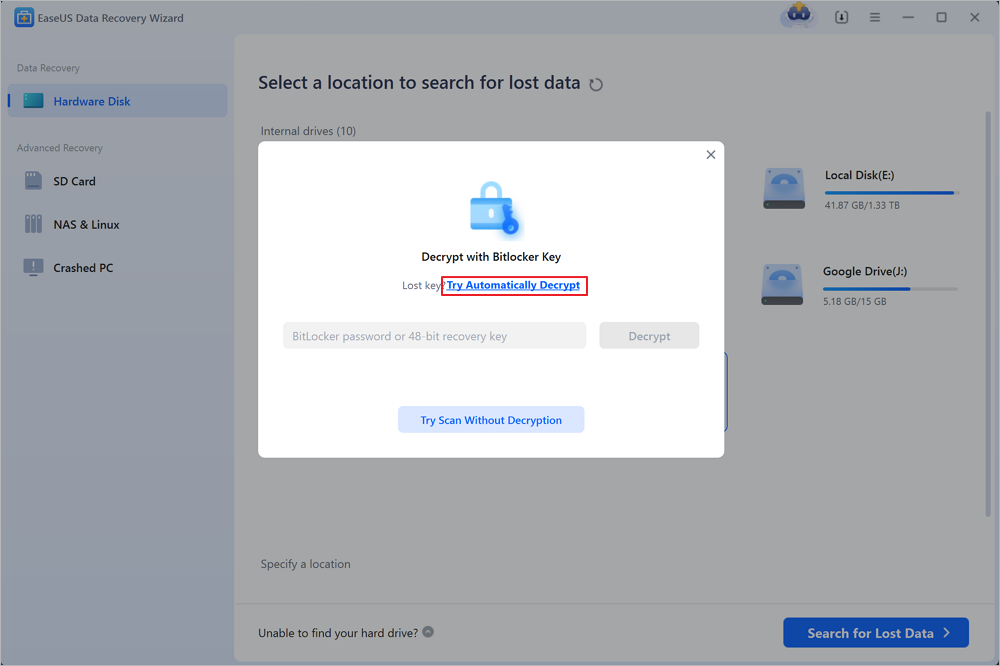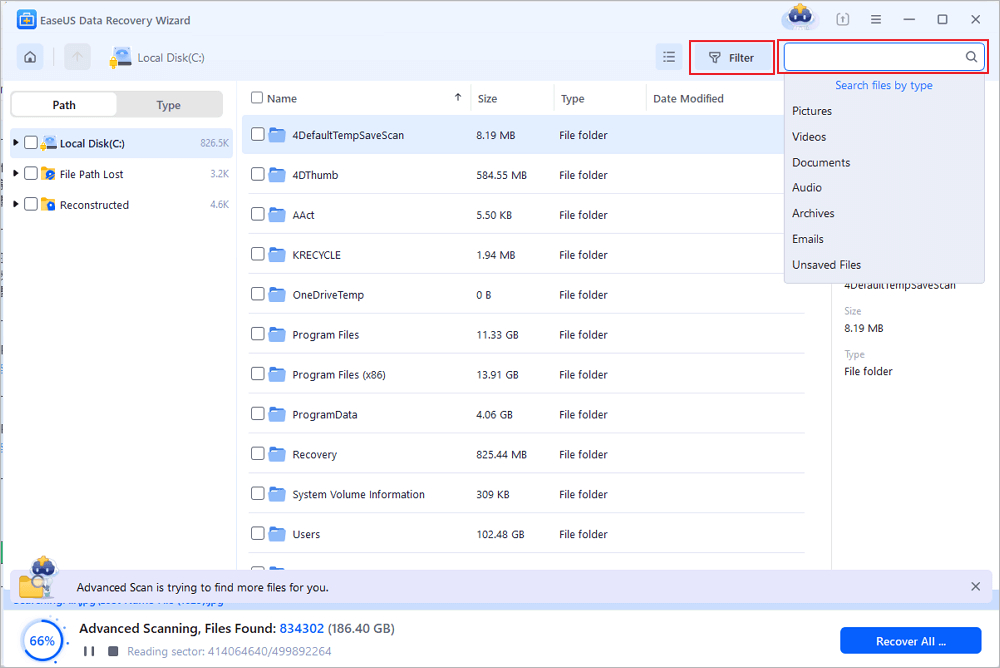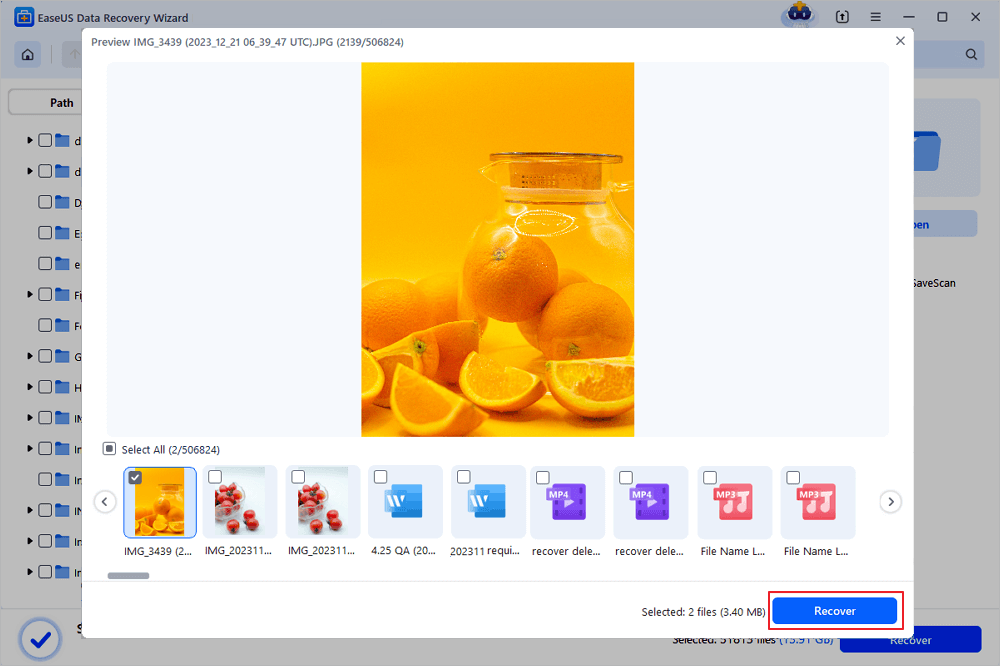Are you wondering what BitLocker recovery is? In this post, we will tell you what BitLocker recovery error is, why it happens, and how to get out of the BitLocker recovery issue in 4 ways. Read on to learn the detailed information!
What Is BitLocker Recovery
Have you been stuck in an infinite loop of BitLocker demanding a recovery key whenever you turn on your PC? The causes of getting the BitLocker recovery screen are the following:
- Obsolete BIOS - BIOS can work haphazardly when it gets obsolete and causes innumerable issues, including the BitLocker recovery screen.
- Erroneous BitLocker password - The BitLocker recovery screen may also appear if you have typed the wrong password several times.
- Safe boot issues - Secure Boot safeguards your PC from viruses. If you’re having problems with the BitLocker recovery system, you may turn it on or off!
- New boot menu errors - Windows 10 owns a new boot menu that can initiate the emergence of the BitLocker recovery screen. However, switching back to Legacy Boot might resolve the issue.

How to Get Computer Out of BitLocker Recovery
A 48-digit numerical password is required when BitLocker can't unlock an encoded drive in Windows automatically. This 48-digit number is vital to retrieve access to the drive, generated by encoding the particular drive using BitLocker encryption technology, known as BitLocker recovery key. It can be stored in distinct locations, including your MS account, a TXT file, a USB flash drive, or a paper document.
Input the right key can get your computer out of the BitLocker recovery issue. How to find a BitLocker recovery key? Several locations are available to find the BitLocker recovery key. Based on the preference that was made while activating BitLocker, below are the ways to get the computer out of BitLocker recovery:
| Workable Solutions | Step-by-step Troubleshooting |
|---|---|
| Fix 1. Linked to Your MS Account | Launch a web browser from your phone or other computers, and visit the recovery key page...Full steps |
| Fix 2. On a Printout | Your recovery key may have been printed when BitLocker was turned on. Evaluate the location...Full steps |
| Fix 3. Connect School/Work Account | Launch a web browser from another device and sign in with your school or work account...Full steps |
| Fix 4. On a USB Flash Drive | Plug the USB flash drive into your locked device and follow the instructions to access the key...Full steps |
Method #1: Linked to Your MS Account
Go through the steps below if the BitLocker recovery key is backed up to your MS account:
Step 1. Launch a web browser from another device and visit this page:
| https://account.microsoft.com/devices/recoverykey |
Step 2. Detect the key ID after signing in with your MS account.
Step 3. To unlock the drive, use the related recovery key.

N.B: If the device was properly set up or someone turned on the BitLocker else, the BitLocker recovery key may be kept in that individual's MS account.
Method #2: On a Printout
Your recovery key may have been printed when BitLocker was turned on. Evaluate the location of the crucial documents you maintain within your device. For instance, in the following printout, the key ID and the relative recovery key are underlined.
If you think this post is informative, share it with your friends on SNS to help more people learn what the BitLocker recovery screen is and how to find the right recovery key to get out of it.
Method #3: Connect Your School or Work Account
If your smartphone was ever utilized to sign in with a work or school account, a recovery code might be kept in the associated account of that organization. You may access it directly or have to contact the IT support for that company to access the BitLocker recovery key. Go through the steps below to connect your Work or School account:
Step 1. Launch a web browser from another device and head to this page:
| https://aka.ms/aadrecoverykey |
Step 2. Sign in with your school or work account.
Step 3. Opt for "Devices" and broaden the device for which you have to restore the recovery key.

Step 4. Opt for the option "View BitLocker Keys".
Step 5. Search for the related recovery key using the key ID and utilize it to unlock the drive.
Method #4: On a USB Flash Drive
All you need to do is plug the USB flash drive into your locked device and follow the instructions. You ought to access the key from another gadget if you saved it on the flash drive as a text file.

Bonus Tip: Fix BitLocker Recovery Key Not Working
Losing access to your BitLocker-encoded disk because of forgetting the password and retrieving the key is annoying. BitLocker safeguards your data, but getting into your vital files might be cumbersome if you forget the password. You may have heard that formatting a disk decrypts it. But this is usually the pesky option, as formatting a disk will ruin all data kept on the disk, including vital files, pictures, and videos.
In that case, you may unlock the BitLocker drive and restore data using the EaseUS Data Recovery Wizard. This professional software can restore vital files from the encoded disk before formatting. This trustworthy and powerful tool can restore BitLocker-encrypted disk data without needing a recovery key or password.
EaseUS BItLocker Data Recovery tool can help decrypt your BitLocker encrypted disk quickly and retrieve your videos, photos, and documents. Download this professional data recovery software now!
Step 1. Choose the encrypted drive to scan
Launch EaseUS Data Recovery Wizard, and you will see the BitLocker encrypted drive displayed there. Hover the mouse on the BitLocker partition or storage device from which you want to recover data. Then click "Search for Lost Data".

Note: If you don't have a key or password, you can use "Try Automatically Decrypt", which may help you scan your recovery key from your Microsoft account or your C drive, then decrypt the drive without providing your password.

Step 2. Select and preview scanned files
The software will start a quick scan for deleted files and perform advanced scan for more lost files from the BitLocker device. When the process completes, you can apply the "Filter" feature or use the search feature to find the lost files in a short time.

Step 3. Recover lost files from BitLocker encrypted hard drive
After previewing the file, click the "Recover" button to restore deleted or lost files from BitLocker encrypted partition on Windows. You can choose a cloud storage, such as OneDrive, Google Drive, etc., and click "Save" to save your recovered files.

Conclusion
If an organization manages your device, you must check with your IT department to restore the recovery key. You will have to factory reset your device using one of the Windows recovery methods if you are unwilling to locate the BitLocker restoration key and reverse the modifications that mandated its use. A factory reset of your system eliminates the files you store; therefore, installing the EaseUS Data Recovery Wizard is important!
What Is BitLocker Recovery FAQs
Go through the FAQs below to comprehend the topic better:
1. How to get rid of BitLocker?
To get rid of BitLocker, you may turn it off by:
- Look for managing "BitLocker" in the Windows search bar.
- Hit "Open > Turn off BitLocker" on the drive you intend to decrypt.
- Confirm your preferences and hit "disable BitLocker" to initiate the process.
2. Why am I getting BitLocker recovery?
Safe boot problems are one of the serious reasons for the emergence of the BitLocker recovery screen. Secure boot safeguards your PC from viruses. You may consider deactivating or activating it while having issues with the BitLocker recovery screen.
3. Can I skip BitLocker recovery?
Skipping BitLocker recovery is possible by pressing "Esc". If you can't spot the BitLocker recovery key and can't undo any modifications that caused it to be required, you will have to reset your system using Windows recovery options. But resetting your system will eliminate all of your files.
Was This Page Helpful?
Brithny is a technology enthusiast, aiming to make readers' tech lives easy and enjoyable. She loves exploring new technologies and writing technical how-to tips. In her spare time, she loves sharing things about her game experience on Facebook or Twitter.
Related Articles
-
Unlock BitLocker Drive Without Recovery Key and Password Free [Full Guide]
![author icon]() Brithny/2025-02-19
Brithny/2025-02-19 -
BitLocker on External Hard Drive: Encrypt & Decrypt Without Recovery Key
![author icon]() Brithny/2025-02-19
Brithny/2025-02-19 -
Clone BitLocker Drive with Clonezilla & Alternative [2025 Guide]
![author icon]() Jean/2025-03-31
Jean/2025-03-31 -
BitLocker Boot Loop: How to Fix It and Boot Properly
![author icon]() Sherly/2025-04-01
Sherly/2025-04-01
EaseUS Data Recovery Services
EaseUS data recovery experts have uneaqualed expertise to repair disks/systems and salvage data from all devices like RAID, HDD, SSD, USB, etc.